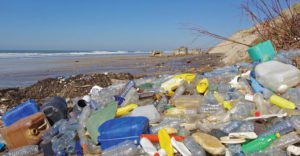
The holidays are a time to practice old traditions and start new traditions. This year, Clean Air Council is urging everyone to create the new tradition of a plastic-free holiday to be more mindful of the waste we create and our plastic usage. From Thanksgiving to New Years, Americans create 25% more waste. With simple and creative steps, we can all reduce this impact during the holiday season. And by avoiding plastics, you lower your exposure to toxic additives like lead and endocrine disruptors. The Council has compiled our favorite ideas for making the holidays more sustainable and plastic-free and we hope that you can put them to use as well as share them with your friends and family.
The Issue with Plastics
The holidays shine a spotlight on consumer behavior and consumption. We buy more, we eat more, and we generally use more “stuff.” Much of what we purchase is packaged in plastic or plastic itself. This plastic is creating a crisis for our health and the environment. From a health standpoint, environmental exposure to plastics and microplastics affects cardiovascular, renal, gastrointestinal, neurological, reproductive, and respiratory systems; impacts include cancers, diabetes, neuro-reproductive and developmental toxicity. Surprisingly, more than half of all plastic ever created was produced in the last 15 years. This plastic is derived from fossil fuels and fueling the climate crisis. While Clean Air Council is working hard to hold plastics producers like Shell accountable, it is also imperative that as a society we take meaningful steps to reduce our plastic consumption. This will not only reduce the toxic plastics problem, it will also help to safeguard our health and that of our loved ones. It is our hope that this guide will help us begin to break free from plastics with simple lifestyle changes around the holidays that lead into the rest of the year.
Spread Holiday Cheer Without Plastics This Year
Decorating
Creating a warm, bright, and cozy environment is a large part of the holidays. With simple steps, you can up your decorating game without relying on plastic. Take stock of what you already own. Go through your boxes of ornaments and decor instead of buying new decorations. Hold a decoration swap with friends and family to “spruce up” what you already own and give away what you are no longer using. Dried orange slices, cranberries, and popcorn are great natural materials for garland that you can hang around the house and on a Christmas tree. They can all be fed to birds after the tree comes down and the holidays are packed away. Oranges with cloves stuck in them look great in a bowl and will make your house smell delicious.
Christmas Tree
If you put up a Christmas tree, it can be hard to decide whether to use real or fake and which is better for the environment. The short answer is that real trees have a lighter impact. Nearly 90% of fake plastic trees are shipped from China. Real trees do not produce nearly the amount of carbon emissions that come from producing and shipping fake plastic trees. Real trees have the added benefit of creating a healthy forest habitat. Many trees in tree farms are left standing after the season and wildlife depend on them. Finally, real trees can be composted after the holiday is over as opposed to shedding microplastics and going to a landfill where most fake trees go after their use.
Gift Wrapping
In the US alone, an estimated 2.6 billion pounds of wrapping paper is thrown away each year, enough to cover 40 football fields. It’s easy to get creative and use reusable materials to create beautifully wrapped gifts. Paper shopping bags and newspapers can be repurposed as wrapping material and can be decorated with paint. In addition to paper bags and newspapers, tea towels and cloth bags are great for wrapping presents. Upcycle cloth ribbons from packaging that you gather throughout the year. If you don’t already have these materials, they are easily found at thrift stores.
Gift Giving
Clothing
Apparel is a common gift but most don’t realize its impact. Textiles are the largest source of primary microplastics (specifically manufactured to be smaller than 5mm), accounting for 34.8% of global microplastic pollution. These microplastics shed in the wash and enter our environment. Polyester and acrylic are the largest offenders. When choosing clothes to give, look for natural materials like cotton and wool. It’s also important to avoid “fast fashion” and buy from sustainable manufacturers or secondhand. Your local thrift and vintage stores are great for buying apparel. Secondhand clothing is also widely available online on websites such as Poshmark and Thred Up.
Toys
Plastic is ubiquitous when it comes to childrens’ toys. We all have memories of excitedly opening a new plastic toy during the holidays. However, not only can these toys contain dangerous toxins like lead, manufacturing them requires dirty petrochemicals. While purchasing an antique toy can seem like a smart solution, many older toys can contain lead. Look for toys made sustainably from natural materials like wood or cotton.
Zero Waste Gift Baskets
Get family and friends started on their zero-waste and plastic-free journeys by putting together a gift basket of helpful items. These can include beeswax wrappers, glass food containers, bars of shampoo and soap, cloth napkins, wool or hemp dryer balls, and stainless steel water bottles. Many of these items can be found in small local stores so you can avoid shipping and packaging.
Clean Air Council Staff Advice
To help celebrate a plastic-free holiday, Clean Air Council’s staff has the following advice:
“I always like the ‘give experiences instead of gifts’ advice, like buying a gift card at a massage place, paying for a snowboard lesson, etc. Gifting homemade food is always good too.” Andrew Woomer, Advocacy Coordinator and Project Manager
“A gift card or a trip to their local bulk goods / refill store! I really like Good Buy Supply on East Passyunk for my laundry detergent.” Alice Lu, Policy Coordinator
“Wrap gifts in fabric, cloth, or hand towels. Thrift stores are perfect for these finds.” Eleanor Breslin, Staff Attorney
“For the more crafty gifter, you can buy a 100% wool sweater at goodwill, unravel it and make your own wool balls. It’s a little time intensive but it’s very affordable and handmade.” Corinne Bishop, Administrator
“For decorations, I like natural items like dehydrated orange slices (on a string for a garland), plant garlands, pine cones on decorative plates or platters, candles, and Christmas flowers (poinsettia, amaryllis, hyacinth). Eucalyptus and any kind of conifers are great for wreaths and other arrangements.” Sanna Kyynäräinen, Project Coordinator
Happy Holidays,
Clean Air Council

Plastics are slowly killing life on earth. We enjoy the convenience of plastics but delude ourselves that we can dispose of them safely. We give little thought to the damage done to the environment and to public health that results from extracting the fossil fuel needed to produce and manufacture plastics. We worry about climate change but stubbornly do not make the connection between plastic production and emissions of greenhouse gases. Most people falsely believe that recycling plastics is the answer — even though the vast majority of plastics can not be recycled and there is no real market for recycled plastics. Most of us will remember that distressing video of a sea-turtle with a plastic straw stuck in its nose. That’s happening every day. Plastics don’t really break down, they turn into dangerous microplastics that we’re now consuming.
Plastics are everywhere — some are necessary, many are not. Food wrappers, cigarette filters, single-use plastic bags, plastic straws, styrofoam.
The easiest plastics to avoid are the single-use plastic items we use for convenience or out of habit. As residents, we pay a high financial cost for single-use plastics. The City of Philadelphia spends between $9 million and $12 million every year cleaning plastic bags from the streets, sewers, and bodies of water. Philadelphia alone uses approximately one billion plastic bags per year, many of which end up as litter in our neighborhoods. Pennsylvania taxpayers spend over $13 million every year just cleaning up roadside litter. This money should be spent on more important things such as public education.
The plastic and petrochemical industry mislead the public by marketing plastics as “recyclable” when in reality, less than 9% of all plastic ever produced has been recycled. There is no viable solution for plastic waste. According to the United Nations Environment Programme, 12% of plastics are burned in incinerators (increasing air pollution in communities of color where waste incinerators are typically located) and 79% of plastics are deposited in landfills, dumps or end up in the natural environment.
Nearly all plastics produced derive from oil, fracked gas, and coal — dirty, non-renewable resources. Plastics and the climate crisis go hand-in-hand: plastic production depends on fossil fuels, and fossil fuels rely on plastic production.
Another hidden cost to single-use plastics: human health. For instance, Royal Dutch Shell’s 386-acre ethane cracker—built to make plastics— is set to power up this year about 25 miles outside of Pittsburgh in Beaver County. Shell’s plant will release 159 tons per year of fine particulate matter and 522 tons per year of volatile organic compounds (VOC), according to the Council’s 2014 Health Impacts Assessment. VOCs exacerbate health conditions including asthma, cardiovascular disease, cancer, endocrine disruption, and adverse birth outcomes.
There are also terrifying new links being made between microplastics and other toxins. Scientists are finding that microplastics accumulate toxins like DDT and PCBs from trace levels that may already exist in the environment, and deliver them to wildlife and humans that eat them, often bioaccumulating through the food chain.
The Council spent more than 10 years advocating to pass a Philadelphia single-use plastic bag ban. However, Philadelphia’s plastic bag ban was delayed one year due to COVID-19 and will now go into effect on July 1, 2021.
The Council advocates for turning off the “plastics tap,” and is fighting legislation that would limit local government’s ability to regulate single-use plastic items. Representing Pennsylvania residents in court, the Council joined the City of Philadelphia, Borough of West Chester, Borough of Narberth, Lower Merion Township, and the City of Pittsburgh in a lawsuit to overturn the state’s unconstitutional preemption of municipalities from enacting or enforcing single-use plastic legislation. The Council is fighting for local residents and leaders to implement sustainable solutions locally to plastic pollution.
It’s time to end our addiction to plastic, enact local solutions, and choose to protect the environment over convenience. Start by ditching single-use plastics for Plastic Free July and spreading the word about plastic pollution.
Written by Jessica Bellwoar, Development Officer, jbellwoar@cleanair.org. For more information on the PA Plastics Preemption lawsuit contact, Logan Welde, Staff Attorney, lwelde@cleanair.org.
Tags: Plastics, recycling, waste, zero waste, litigation

